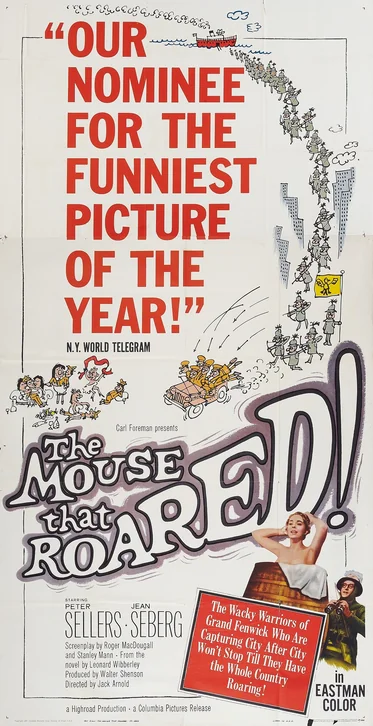🎯 Quick Overview
Trailer
- Director: Jack Arnold
- Genre: Comedy, Satire, War
- Release year: 1959
- Runtime (length): 1h 23min
- IMDb rating: 6.9/10 (9.8K votes)
- Rotten Tomatoes: 89%
😅 Plot Summary – Badly Explained
A tiny, broke country declares war on the US just to lose and get foreign aid, but accidentally wins the world’s most powerful bomb and now everyone wants a piece of their newfound super-status.
🍿 The Mouse That Roared: Detailed Plot Synopsis
Grand Fenwick’s Financial Straits
The Duchy of Grand Fenwick, a tiny, secluded nation nestled in the French Alps, prides itself on its traditional way of life and its sole export: the unique Pinot Grand Fenwick wine. However, their peaceful existence is threatened when a Californian vintner begins producing a cheap knock-off, drastically undercutting Grand Fenwick’s wine in the U.S. market and pushing the small country to the brink of bankruptcy. After repeated protests to the United States go unanswered, Grand Fenwick faces an unprecedented economic crisis. The Prime Minister, Rupert of Mountjoy (Peter Sellers), devises an audacious and seemingly foolproof plan to save their nation: declare war on the United States.
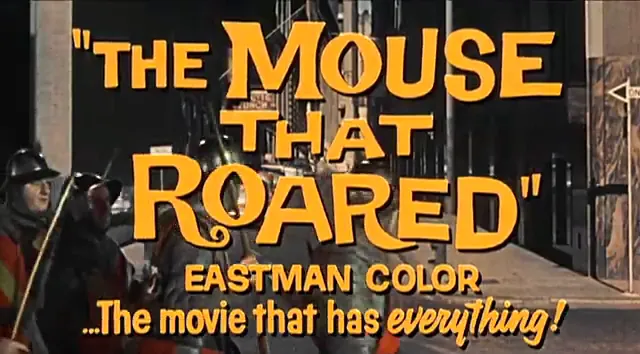
The Master Plan: Declare War and Lose
Mountjoy’s unconventional strategy is based on historical precedent: the U.S. has a track record of providing significant financial aid and resources to rebuild defeated nations. The idea is to declare war, promptly lose within a day with no casualties, and then reap massive post-war compensation to restore Grand Fenwick’s economy. Grand Duchess Gloriana XII (also Peter Sellers) reluctantly supports this desperate measure. The chosen leader for this peculiar invasion is Tully Bascombe (Peter Sellers), a seemingly hapless forest ranger who also holds the hereditary titles of head field marshal and grand constable. His army consists of approximately twenty men, armed with anachronistic longbows and arrows. The plan seems simple: sail to New York City and immediately surrender upon arrival, ensuring a swift and bloodless defeat.
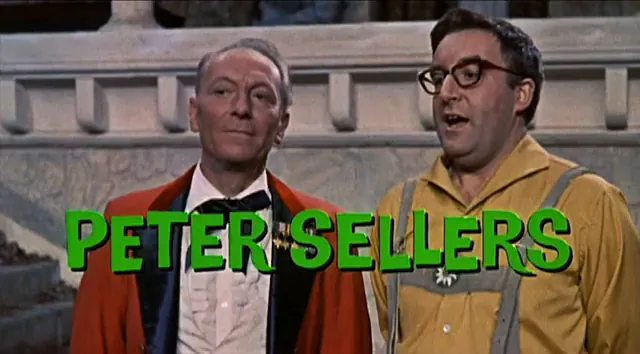
An Unforeseen Arrival in New York
The Grand Fenwick army’s journey to New York City is fraught with minor mishaps, including a comical encounter with a passenger liner. Upon reaching Manhattan, they find the streets eerily deserted, a result of a city-wide air-raid drill that has sent New Yorkers into shelters. The U.S. official who received Grand Fenwick’s declaration of war dismissed it as a prank, leading to a complete lack of preparations or opposition to their arrival. Unable to find anyone to surrender to, Tully and his men stumble upon the laboratory of Dr. Alfred Kokintz, who is developing the Q-bomb, a weapon exponentially more deadly than the hydrogen bomb. Seeing an opportunity, Tully unexpectedly decides to capture the scientist and his devastating invention.
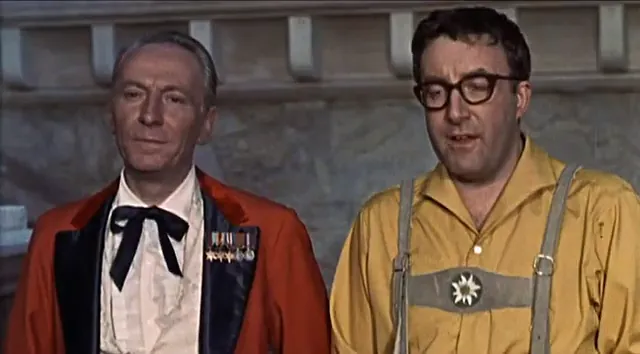
⚠️ Spoilers and Ending Explained
🎬 Cast & Characters
- Grand Duchess Gloriana XII (Peter Sellers): The aging monarch of Grand Fenwick who reluctantly approves the unconventional plan to declare war on the U.S. for financial aid.
- Count Rupert of Mountjoy (Peter Sellers): The clever Prime Minister of Grand Fenwick who devises the bizarre strategy of declaring war on the U.S. to intentionally lose and receive foreign aid.
- Tully Bascombe (Peter Sellers): The inept and seasick forest ranger promoted to Field Marshal, who accidentally leads his medieval army to victory against the U.S., creating an unexpected international crisis.
- Helen Kokintz (Jean Seberg): The intelligent daughter and assistant to Dr. Kokintz, who is taken hostage by the Fenwickian army and becomes an unexpected love interest for Tully.
- Doctor Alfred Kokintz (David Kossoff): The brilliant American scientist responsible for inventing the world-destroying Q-bomb, who is inadvertently captured by the invading Grand Fenwick forces.
- Will Buckley (William Hartnell): The stern and pragmatic lieutenant to Tully Bascombe, who assists in the unlikely invasion of New York and manages the captured Americans.
💬 Memorable Quotes
- Grand Duchess Gloriana: “How did the war go?” – Asked eagerly by the Duchess upon the army’s return, anticipating a quick and strategic defeat as planned.
- Tully Bascombe: “Well, Your Grace, we’re home. Actually, there’s been a slight change of plan. I know it will come as a surprise, a pleasant one, I hope, but we sort of won.” – Tully’s sheepish announcement to the Grand Duchess and Prime Minister, revealing that their meticulously planned defeat had unexpectedly turned into a victory.
- Prime Minister Count Rupert Mountjoy: “You sort of WHAT?!” – Mountjoy’s incredulous and highly frustrated reaction to Tully Bascombe’s utterly unexpected revelation that Grand Fenwick had ‘sort of won’ the war against the U.S.
- Prime Minister Count Rupert Mountjoy: “There isn’t a more profitable undertaking for any country than to declare war on the United States and be defeated.” – Mountjoy outlining his ingenious and cynical plan to the Grand Duchess, based on the historical generosity of the U.S. towards defeated nations.
- Prime Minister Count Rupert Mountjoy: “Only an imbecile could have won this war, and he did!” – Mountjoy’s exasperated and iconic line, delivered in sheer disbelief and irony, about Tully Bascombe’s bumbling yet successful ‘victory’.
💰Box Office
- Budget: $450,000
- Domestic Gross: $2,000,000
- Worldwide Gross: $2,000,000
💥 The Mouse That Roared Reviews
Personal Review
I absolutely adored ‘The Mouse That Roared’! Peter Sellers playing three different characters, including the Grand Duchess, is just pure genius. I kept forgetting it was him, which is the mark of a true master. The whole idea of a tiny country trying to lose a war to get aid is so hilariously absurd and surprisingly smart. It’s got this wonderful, gentle British humor that just made me smile the entire way through. That scene with the Q-bomb and the American general? Priceless. It’s a charming, witty film that holds up incredibly well and genuinely made me laugh out loud. Highly recommend if you love clever comedies!
- Who would enjoy:
- “Fans of Peter Sellers’ comedic genius”
- “Enthusiasts of classic British comedies”
- “Viewers who appreciate political satire and social commentary”
- “Those interested in Cold War-era films and themes”
- “Audiences who enjoy quirky, unconventional humor and farcical plots”
- Content warnings ⚠:
- “Mild thematic elements related to nuclear warfare satire”
- “Comical depictions of international conflict”
Professional Reviews
- Vintage Cinema Digest: “Jack Arnold’s ‘The Mouse That Roared’ is a wonderfully sharp Cold War satire, perfectly timed for its era but surprisingly evergreen. Peter Sellers delivers a masterclass, inhabiting three distinct roles with effortless charm and comedic timing. While it maintains a gentle, light-hearted tone, the film cleverly skewers international politics and nuclear paranoia, making you laugh while you ponder its shrewd observations. A true British comedy gem that’s still relevant today.
- The Daily Critic: “‘The Mouse That Roared’ is an absolute delight, showcasing Peter Sellers’ chameleon-like talent in three memorable performances. The premise – a tiny nation trying to lose a war for financial gain – is brilliantly absurd and unfolds with charming wit. It’s not a laugh-a-minute slapstick, but rather a sophisticated farce that relies on smart dialogue and hilarious situations. A must-see for fans of classic British humor and satirical storytelling.
Audience Reactions
Peter Sellers’ unbelievable performance across multiple distinct roles is a constant source of amusement and admiration.: Viewers consistently praise the film’s intelligent satire on Cold War politics and international relations, finding it both funny and insightful.
The core concept of a tiny nation accidentally winning a war they planned to lose is universally loved for its comedic brilliance.: Many appreciate the movie’s charming, subtle humor and its ability to deliver meaningful social commentary without resorting to overt slapstick.
Overall Consensus: A highly praised Cold War satire that remains charming and witty, primarily driven by Peter Sellers’ iconic multi-role performance and its clever, absurd premise.
Awards
🛠️ Behind the Scenes
- “Peter Sellers, an actor schooled in improvisation, often found that his best work came from the first take and would struggle to keep his performance fresh if multiple takes were required.”
- “The film features a unique, humorous alteration to the iconic Columbia Pictures logo at both the beginning and end: the Torch Lady is startled by a mouse and runs off at the start, returning to her pedestal at the film’s conclusion.”
- “To achieve the look of a deserted New York City for the invasion sequence, filming took place on a Sunday morning in Manhattan, while the ‘Marseilles’ and ‘New York harbor’ scenes were actually shot in Southampton, UK, with the presence of the Queen Elizabeth ocean liner being a fortunate coincidence.”
- “Peter Sellers consciously took on three distinct roles (Grand Duchess Gloriana XII, Prime Minister Count Rupert Mountjoy, and Tully Bascombe) in an effort to emulate Alec Guinness’s acclaimed multi-character performance in the 1949 Ealing comedy ‘Kind Hearts and Coronets’.”
- “The Q-Bomb in the film was notably designed to resemble a football, which was a subtle, insider reference to the real-life ‘football’ briefcase carried by U.S. presidential aides, containing the nuclear launch codes – a detail not widely known to the public at the time.”
🖥️ How to Watch The Mouse That Roared?
As a classic Cold War satire, ‘The Mouse That Roared’ is widely available for those looking to experience Peter Sellers’ iconic triple performance. You can typically find it available for rent or purchase on major digital platforms like Amazon Prime Video, Apple TV, Google Play, and YouTube. Check your preferred service for the most current streaming and buying options to add this timeless comedy to your collection.
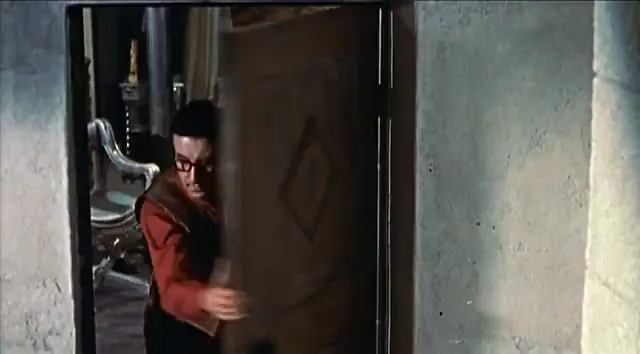
🎥 Similar Movies
If you enjoyed The Mouse That Roared, you might like these similar films:
- Dr. Strangelove or: How I Learned to Stop Worrying and Love the Bomb (1964): A quintessential Cold War-era nuclear satire, also starring Peter Sellers in multiple iconic roles, exploring themes of international politics and the absurdity of mutually assured destruction.
- Kind Hearts and Coronets (1949): A classic British Ealing comedy where Alec Guinness famously plays eight different characters, serving as a direct inspiration for Peter Sellers’ multi-role performance in ‘The Mouse That Roared’.
- Duck Soup (1933): A quintessential Marx Brothers political satire, featuring a small, fictional nation engaged in absurd and farcical declarations of war, mirroring ‘The Mouse That Roared’s’ blend of political commentary and slapstick comedy.
- Wag the Dog (1997): A sharp modern political satire about a spin doctor and a Hollywood producer who invent a war to distract the public from a presidential scandal, echoing ‘The Mouse That Roared’s’ themes of manufactured conflict and geopolitical manipulation.
🛒 The Mouse That Roared Related Products
- The Mouse That Roared (The Criterion Collection) Blu-ray: Experience this comedic masterpiece in stunning high-definition, featuring restored video and audio, along with exclusive bonus content like interviews, behind-the-scenes footage, and analytical essays that delve into the film’s lasting impact.
- The Mouse That Roared by Leonard Wibberley (Paperback): The original satirical novel that inspired the classic film. Dive deeper into the nuanced humor and political commentary of the Duchy of Grand Fenwick’s misadventures, exploring character backstories and plot details not seen on screen.
- Grand Fenwick Duchy Crest T-Shirt: Show your allegiance to the world’s smallest (and most triumphant) nation with this high-quality cotton T-shirt featuring the distinctive crest of the Duchy of Grand Fenwick. Available in various sizes and colors.
- Vintage ‘The Mouse That Roared’ Movie Poster Reproduction: A high-quality, authentic reproduction of the original theatrical release poster for ‘The Mouse That Roared’. Perfect for framing, this poster captures the iconic imagery and vibrant design of the 1959 comedy.
🎧 Soundtrack
The Mouse That Roared features a captivating soundtrack that enhances the movie’s atmosphere and emotional impact. Here are some notable tracks:
- “Romeo and Juliet Love Theme” – performed by Pyotr Ilyich Tchaikovsky
- “Frankie and Johnnie” – performed by Traditional
You can find the complete soundtrack on Amazon Music and Apple Music.
🤨 FAQ
Yes, ‘The Mouse That Roared’ is a satirical comedy, specifically known for its witty take on Cold War politics and international relations. It’s considered a classic British comedy.
Peter Sellers famously plays three distinct characters in ‘The Mouse That Roared’: the elderly Grand Duchess Gloriana XII, the scheming Prime Minister Count Rupert of Mountjoy, and the bumbling but honorable Field Marshal Tully Bascombe.
The film follows the tiny Duchy of Grand Fenwick, which, facing bankruptcy, decides to declare war on the United States. Their plan is to lose quickly and receive substantial post-war financial aid, but things go hilariously awry when they accidentally win the war by capturing a super-powerful ‘Q-bomb’.
Yes, ‘The Mouse That Roared’ has a sequel titled ‘The Mouse on the Moon’, released in 1963. However, Peter Sellers did not reprise his multiple roles in the sequel.
The mouse in ‘The Mouse That Roared’ is primarily a running gag related to the Columbia Pictures logo. At the beginning, the Torch Lady spots a mouse and runs off her pedestal. At the end, after the Q-bomb is dropped, a small white mouse emerges, playfully suggesting it was a dud all along, tying back to the initial gag and symbolizing the ‘mouse’ of Grand Fenwick’s unexpected ‘roar’.
🔥 Bonus Content
Columbia Pictures (1959)
Ever wondered how classic films like ‘The Mouse That Roared’ kicked off their cinematic experience? Take a quick trip back in time to 1959 and see the iconic Columbia Pictures logo exactly as audiences saw it before this Peter Sellers classic began! It’s a fun, authentic piece of the movie’s history.
✨ Rate
There are no reviews yet. Be the first one to write one.


